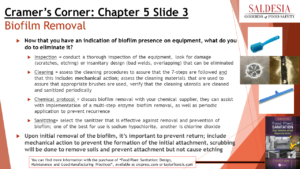Biofilm Removal


Slide Content
Now that you have an indication of biofilm presence on equipment, what do you do to eliminate it?
– Inspection = conduct a thorough inspection of the equipment, look for damage (scratches, etching) or insanitary design (bad welds, overlapping) that can be eliminated
– Cleaning = assess the cleaning procedures to assure that the 7-steps are followed and that this includes mechanical action; assess the cleaning materials that are used to assure that appropriate brushes are used, verify that the cleaning utensils are cleaned and sanitized periodically
– Chemical protocol = discuss biofilm removal with your chemical supplier, they can assist with implementation of a multi-step enzyme biofilm removal, as well as periodic application to prevent recurrence
– Sanitizing= select the sanitizer that is effective against removal and prevention of biofilm; one of the best for use is sodium hypochlorite, another is chlorine dioxide
Upon initial removal of the biofilm, it’s important to prevent return; include mechanical action to prevent the formation of the initial attachment, scrubbing will be done to remove soils and prevent attachment but not cause etching
